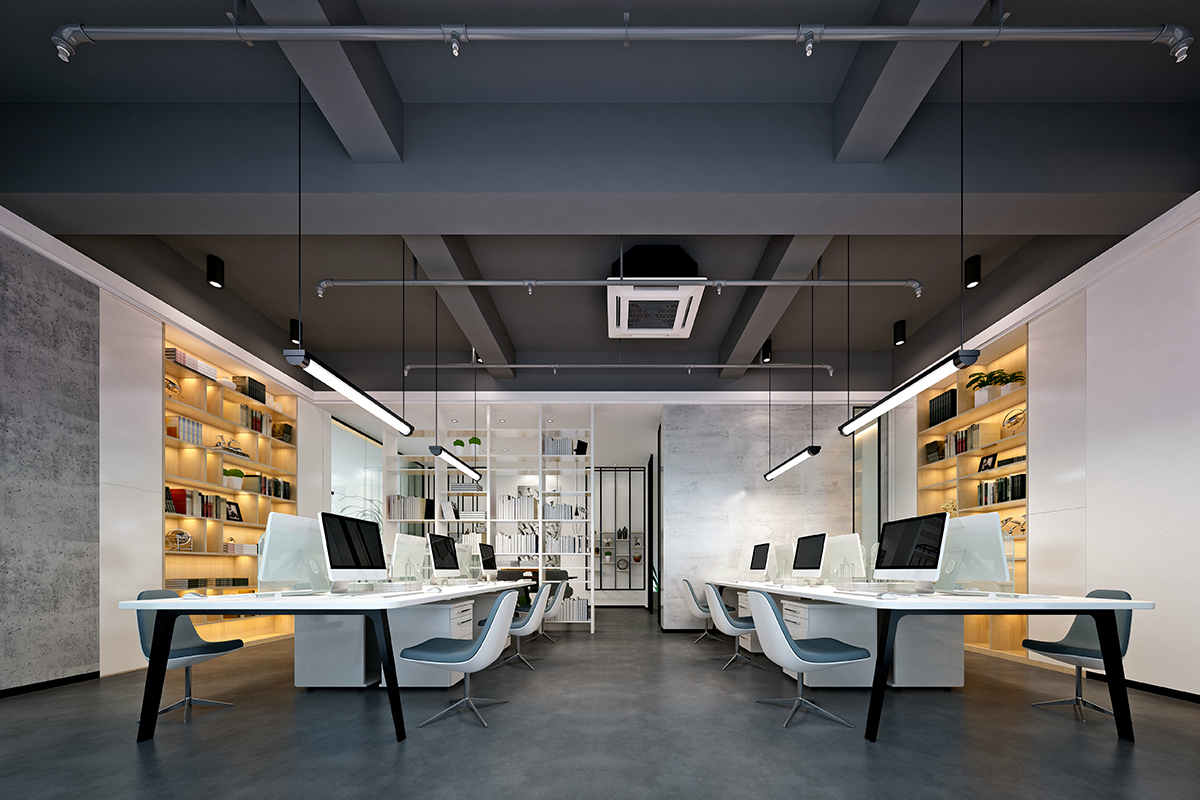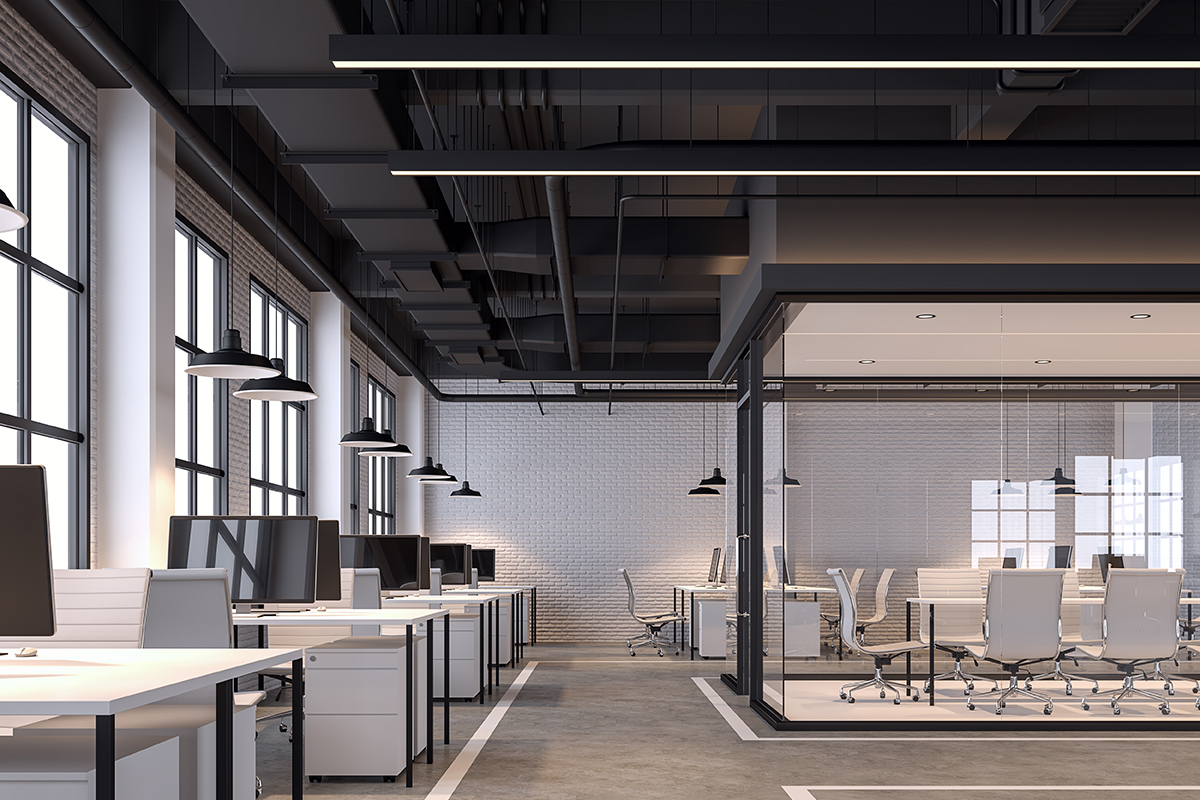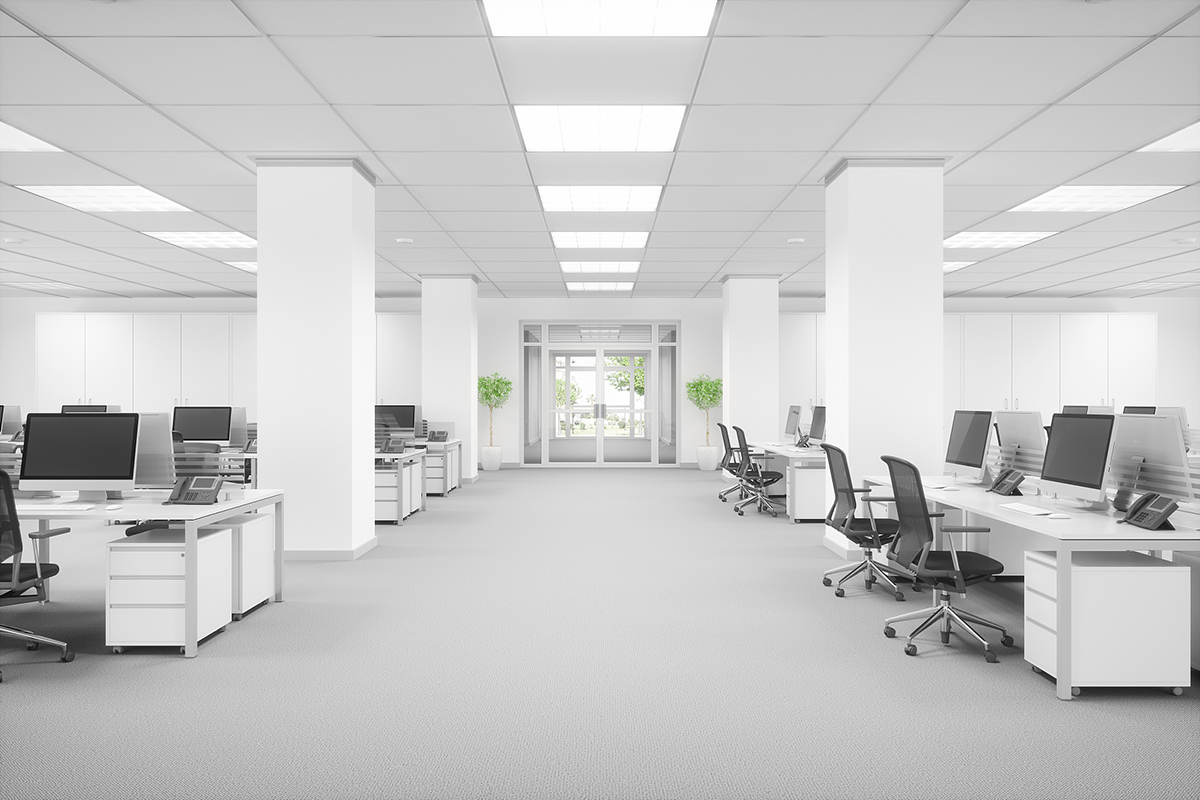Table of Contents Hide
- 1 Office Lighting Is Deemed of High Quality
- 2 Office Lighting and Worker Productivity
- 3 Design Considerations
- 4 Color Requirement
- 5 Glare Control
- 6 Office Lighting Design
-
7
Office Lighting Fixtures
- 7.1 Troffer Lights
- 7.2 Edge-lit LED Panel Lights
- 7.3 Linear Trunking Systems
- 7.4 Pendants and Low Bay Lights
- 7.5 Portable Task Lights

Office Lighting Is Deemed of High Quality
Lighting is an activity or a function to brighten a specific space by making use of various kinds of light sources with a particular application. The primary purpose of lighting in the office space is to support work and promote the working experience by offering a comfortable, attractive environment for the office staff. Lighting is a critical element of the interior design which could enhance or degrade the work experience and impact the well-being of the workers. Lighting can have an impact on behavior, satisfaction, enthusiasm, psychological responses to a space and task performance, organizational commitment, communication and interest, visual comfort, safety and security, while defining space and architecture.Office Lighting and Worker Productivity
Office work is visually demanding and requires high quality lighting to increase productivity, improve comfort, and prevent eyestrain. An office needs to be designed with comfort and productivity in mind, incorporating lighting that reflects the tasks at hand. Visual discomfort has been established to interfere with employee's job performance and overall productivity. Appropriate office lighting has been confirmed to increase creativity potential. Professional office lighting design means delivering adequate illumination in specific areas so people can see printed, handwritten or displayed documents clearly, whilst not over illuminating areas where computer work is performed. Higher visual acuity as a result of optimal office lighting conditions contributes to better performance and/or lower levels of eye strain. Beyond supporting worker performance, a visually comforting environment reinforces the corporate image.Office lighting requirements have fundamentally evolved and technical advancements offer users unprecedented possibilities, e.g. in terms of visual comfort, energy efficiency, control and design. Office lighting plans are required to be cohesive and effectively illuminate diverse varieties of of spaces that exist together under one roof. Office lighting design must encompass lighting solutions for specific areas, which includes open-plan spaces with a multitude of cell offices, private offices, conference rooms, meeting rooms, videoconference rooms, sample display rooms, drafting and graphic production rooms, reception areas, files, restrooms, public areas, hallways, cafeterias, auditoriums, support spaces, plants (vegetation), and emergency lighting. Office lighting must integrate and balance ambient, task, accent, and decorative lighting into each area of the office. Open-plan offices are a world on their own, accommodating sizable numbers of occupants, needing to meet the requirements of individual workers and simultaneously creating positive and motivating overall atmospheres.

Design Considerations
Lighting requirements in offices are extremely diversified and expectations are high. The term "lighting quality" is the integration of human needs, architecture, and economics and the environment. Quality, flexibility and efficiency are the key design considerations for office lighting. Achieving quality lighting goes beyond merely specifying the illuminance level necessary for a specific task to be visible. Design issues most notably glare, shadows, brightness, light patterns, light distribution, luminance contrast, flicker, and color appearance may all affect the office worker's visual comfort, social interactions, aesthetic perceptions, team engagement, environmental and job satisfaction, organizational commitment, and task performance. Light loss factors, specific room reflectances, and other design criteria should be employed to fine-tune lighting calculations.Color Requirement
Office lighting must accommodate many different human needs. Two organically connected application considerations exist with respect to color and light sources: the chromaticity (correlated color temperature, or CCT) and the color rendering properties (color rendering index, or CRI) of the source. Chromaticity describes the color appearance of the light emitting from the lighting source itself and is the absolute temperature of a blackbody whose chromaticity closely resembles that of the light source. The color temperature observed visually affects the aesthetics of different objects. The color characteristics of lamps (chromaticity and color rendering) will influence the visual impression and impact of colors used in a space. Quality artificial lighting attempts to replicate the characteristics of natural light. CCT is designed to characterize the apparent "tint" of the illumination (e.g., warm or cool) produced by a luminaire. Color temperature is a characteristic of visible light which has important applications in lighting. Lower color temperatures generally indicate white light which includes a more significant red component or a "warmer feel," whereas higher color temperatures generally denote white light possessing a more significant blue component or a "cooler feel." Color reproduction is frequently measured using CRI or average color rendering index (CRI Ra). CRI and CRI Ra are developed to define how closely an artificial light source matches the color rendering of a natural light source at the same correlated color temperature. In general, the higher the CRI of a light source, the more vibrant the color appearance of an object will be. For general office lighting, a CRI of a minimum of 80 is recommended. Where color discrimination is important, light sources with a CRI of 90 or greater should be employed.
Glare Control
The comfort of illumination is assessed by a process of evaluating presence of glare in line with the factors. Glare occurs when luminances, or luminance ratios, are exorbitant in relation to the state of adaptation. Glare may be attributed to light cast to the eye straight from a light source (direct glare), or indirectly from a reflective surface (reflected glare). Glare is disturbing in an office environment, as it may obscure the image on a computer monitor and can also induce physical discomfort. The consequences of glare could possibly be disability (an injury in visual capabilities), or discomfort (without necessarily compromising the ability to see). The degree of glare is typically reflected by either of this model: the Visual Comfort Probability (VCP) model, or the Unified Glare Rating (UGR) model. VCP is a glare rating system used in North America. Most of the world outside North America uses UGR to evaluate discomfort from glare. A UGR of 19 is recommended in offices while industrial areas intended for coarse work a UGR of 28 can tolerated. In the United States, office lighting fixturess are required to have a VCP of 80 or greater (i.e., acceptable glare sensations in 80% of the population). To avoid discomfort glare, luminances at higher angles should be less than 8,000 cd/sqm, regardless of whether from exposed light sources or luminaire surfaces such as lenses, diffusers, louvers or reflectors visible to the people in the room.Office Lighting Design
Lighting in offices is generally provided as a combination of different types of lighting systems. Luminaires for office lighting can be categorized by type into ambient or general lighting fixtures, task lighting fixtures for improving localized higher light levels, and accent lighting fixtures for aesthetic interest and visual relief. Direct, indirect, and direct/indirect fixtures allow a number of options for general office lighting design. Direct lighting typically casts a beam in wide angles and can make the work plane the brightest surface in the space. Direct lighting fixtures are usually luminaires mounted overhead in the ceiling or on pendants. Indirect lighting illuminates the ceiling, which then reflects light downwards. As a result, the ceiling gets to be the brightest surface at the observer's sight. Many people consider this type of lighting more comfortable than direct lighting because indirect lighting makes a space feel stereoscopically bright and rarely creates shadows. Direct/indirect lighting combines both downward and upward light distributions, which overcome the shortcomings of each individual lighting technique. Direct/indirect systems in addition provide flexibility in maximizing luminaire spacing distance, making it possible for reduced energy consumption while achieving homogeneous lighting at the work level.An ambient or general lighting system in some applications is supplemented with localized task lighting and accent lighting. Office tasks involves reading, writing and intermittent oral communication. Integrated ambient and task lighting systems are very effective in office settings considering that the ambient illumination delivers an impression of spaciousness, balances daylight, and supports the sense of visual clarity. The application of task and accent lighting will reinforce the perception of a relaxed atmosphere, give visual comfort and help reduce fatigue. Task lighting fixtures have a very flexible installation and may be built into the workstation, mounted on partitions, attached to work surfaces, or simply placed on the desktop.
Office Lighting Fixtures
The selection of office lighting fixtures depends upon a number of factors; color requirements (CCT and CRI), switching/ dimming requirements, light control, maintenance schedule, lamp life, start-up time, and most importantly, the photometric distribution of the light source and lighting fixture combination. New technology has changed indoor lighting with the introduction of new light sources and control techniques. The energy efficiency is also an important working point to cut energy costs while achieving uniform lighting. Recent trends have made it a market-driven adoption to replace energy-inefficient incandescent and fluorescent lamps with more energy-efficient light emitting diode (LED) luminaires. The architectural lighting applications for LED lighting fixtures have witnessed rapid growth as improvements in luminous efficacy and chromaticity, making them into viable options for many applications. LED lamps in linear, recessed and suspended versions bring superb ambient, direct and indirect lighting into the workplace - along with the added bonus of energy efficiency, long lifespan, improved robustness, fast switching, easy maintenance, and excellent durability and reliability.



















































































































